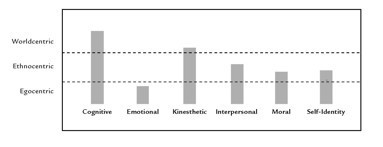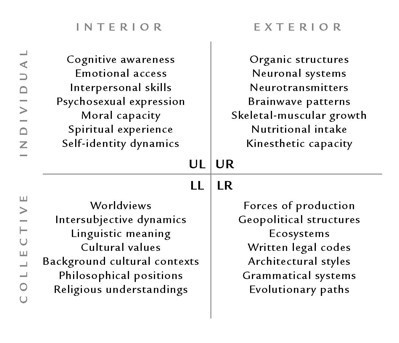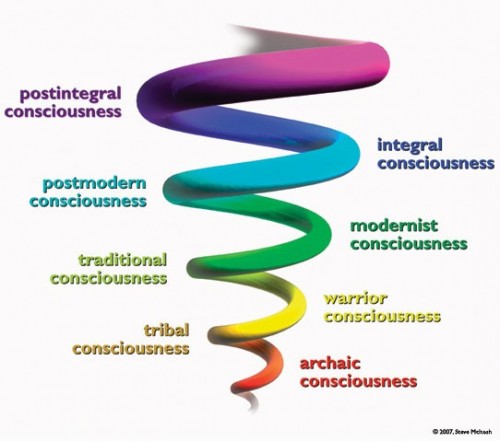All Lines: Various Developmental Capacities
Lines of development are another way to describe the distinct capacities that develop through levels in each aspect of reality as represented by the quadrants. So if levels are contour-lines on a hiking map for reality, then lines of development represent the various trails you can take to transverse the vast wilderness of human potential. For example, in the individual-interior quadrant of experience, the lines that develop include, but are not limited to, cognitive, emotional, interpersonal, and moral capacities. These capacities are often thought of as the multiple intelligences that each person has. The idea being that each of us is more developed in some areas than others. Integral theory uses a psychograph to depict an individual’s unique assortment of development in various individual lines (Fig. 7).

Figure 7. A psychograph

Figure 8. A sociograph
Similarly, a sociograph is used to represent the various lines of development within a family, group, culture, or society (Fig. 8). The kinds of lines found in cultures include things like kinesthetic capacities, interpersonal maturity (e.g., absence of slaves, women’s rights, civil liberties), artistic expression (e.g., forms of music, government funding for the arts), cognitive or technological capacities, physical longevity (e.g., healthcare systems, diet), and polyphasic maturity. Polyphasic refers to a culture’s general access to different states of consciousness. For example, many indigenous cultures embrace access to and cultivation of different kinds of states of awareness while rational Western societies tend to emphasize rational waking consciousness at the exclusion of other modes of experiencing reality. An integral practitioner can use lines as a diagnostic tool to ensure these aspects of individuals or groups are acknowledged and effectively addressed. Below is an overview of the kinds of lines that can be included in an integral assessment.
Each line within a quadrant has correlates in the other quadrants. For example, as the cognitive line develops in the UL quadrant there are corresponding behavioral and neurophysiological developments in the UR quadrant, corresponding intersubjective capacities in the LL quadrant, and grammatical structures in the LR quadrant. In fact, there are a variety of lines in each quadrant. Above I listed some of the common lines associated with the UL. Lines associated with the UR include the developmental pathways of things like skeletal-muscular growth, brainwave patterns, the neuronal system, and other organic structures of the body. In the LL we find lines such as the sequence of worldviews and cultural values, various intersubjective dynamics, religious and philosophical view points, and linguistic meaning. Lastly, in the LR specific lines include how ecosystems develop as well as evolutionary pathways of adaption, geopolitical structures, and forces of production (Fig. 9).

Figure 9. Some lines in the four quadrants.
What distinguishes a line from other patterns such as states or types is that a line demonstrates sequential development with increasing levels of complexity or depth that transcend and include the previous level. In other words, there has to be an identifiable series of stages that unfold in a particular order and any given stage cannot be skipped. For example, within the LR line of forces of production we see a societal path starting with foraging (e.g., hunting and gathering) giving way to horticulture (e.g., using a hoe) giving way to agrarian methods (e.g., using a plow) and so forth—each new development is dependent on what came before and is in part a response to the limits of that previous level.

The lines element especially demonstrates how integral theory includes the contributions of many existing fields and organizes them in a useful way. Also, lines are important to integral practitioners because they identify distinct aspects of each quadrant that demonstrate development and evolution. By being aware of the specific dynamics of growth and the typical trajectory of such transformation, a practitioner can better support and make use of these streams of development. Consequently, integral assessments will often identify which lines are strong and which ones are in need of attention, leveraging the more developed ones to assist in addressing the limits of the less developed ones. Knowing the level of development within various lines provides integral practitioners with valuable information about the realities of a given situation and helps the practitioner align those realities for optimal improvement.
As with the other elements of the AQAL model, we do not have to go far to discover lines in our immediate awareness. Just recall a recent moment where you felt stretched or challenged, such as giving difficult feedback to a colleague or trying some new task that required a high level of hand-eye coordination. Now bring into your awareness an area where you are often more capable than your colleagues, such as seeing multiple perspectives at the same time on some complex situation or an ability to emotionally connect to your friends and describe—better than they can—what they are feeling. Drawing on personal examples of areas where you are less or more developed than people around you shows we all have a unique combination of lines at various levels of development. In fact, rarely a day goes by that we are not aware of the truth of this within ourselves and in our interactions with others. Besides, life would be significantly less interesting if everyone was equal in depth and complexity in most areas.


